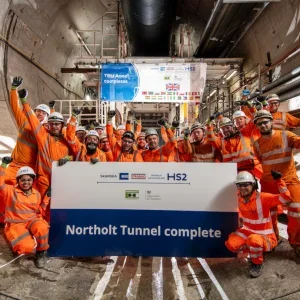On 8 November, the 23km long headrace tunnel for the US$750M Tala hydropower project in Bhutan was completed after delays of more than seven months to the schedule following adverse geological conditions.
The 23km long headrace tunnel is built to a 6.8m finished diameter as a 50m2 modified horseshoe with concrete lining. Some of the five Atlas Copco Boomer 352 drill rigs supplied to the project have been used in the headrace tunnel and achieved an average advance of 120m per month in the best quality conditions encountered and 70m per month in poorer rock conditions. The worst conditions slowed advance to 30m per month as ribs were installed at less than one metre intervals, with rockbolts, mesh and shotcrete or concrete infill also standard.
The location of the project in the remote Himalayan kingdom originally led to challenges in the delivery, commissioning and maintenance of equipment to the five project sites. In August 2000, monsoons caused devastating floods that washed out access roads and flooded tunnels, as well as disrupting the already difficult communication networks and it took six months for the contractors to re-establish the sites. Poor ground conditions were encountered in March 2003 which led to stability problems and lessened advance rates. This year, in mid October, when there was only 20m left to excavate, project officials must have kept previous problems in mind and were unassuming when they talked to the press: “If the tunnel collapses, then the stretch of 20m can take about a year.”
The Tala Hydropower Project Authority (THPA) is a client body set up by the government of India and the Royal Bhutan government.
The civils works contracts were awarded by THPA to three contractors; Jaiprakash Industries Ltd, Hindustan Construction Co. and Larsen & Toubro Ltd.
In addition to the production drill rigs, Atlas Copco also supplied five Boltec 435H rigs for ground support activities and a fleet of sixteen MT-420 20t dump trucks for muckaway purposes.
The focus of activities for the THPA is the remaining rockwork. The 163m deep surge shaft is planned for completion by the end of this year and the two 1.1km long pressure shafts are targeted to be finished by the end of February next year.
The 1020MW project is expected to start producing electricity in mid 2006.







